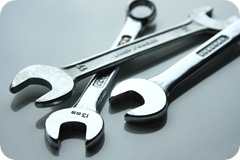BlogEngine.NET 1.5 Upgrade Guide
 With the final release now out the door, I want to take a little time to walk you through the process of upgrading your version of BlogEngine.NET.
With the final release now out the door, I want to take a little time to walk you through the process of upgrading your version of BlogEngine.NET.
As you’d expect, the upgrade process is fairly easy, however, I try to go into lots of details to cover as many different scenarios as I can. While the following guide is long, I fully expect, most of you will be able to skip a section or two along the way and be upgraded quickly and painlessly.
This guide was written from the perspective of upgrading from 1.4.5 to 1.5. If you were one of the people who tried out the 1.5 release candidate, this will work fine for you too. If you are using an older version, it would be best to read this over, but also to look at some of the past upgrade guides to learn about some other important changes.
1. Backup
This is my favorite step in the process. If you do this, there should be no fear of upgrading and in the horrific case of a problem, you can just revert back to your backup.
If you can’t bring yourself to backup the whole blog, be sure to at least get your App_Data folder, your themes and extensions, and your web.config file.
2. Download BlogEngine.NET 1.5 (web)
I’m sure you have already done this step, but if you haven’t, this is the time. You can download it here.
Once you have it downloaded, go ahead and unzip it and then remove the read only check in the properties. (apply to all subfolders and files).
3. Update your data and configuration
If you use the default XML data storage, you can move along to the next step. If you are not sure, you are likely using the default option, so you should move on too.
Welcome database person. It is time to update your database. It is a small change, but required.
In the newly downloaded BlogEngine folder, you will see a Setup folder. In this folder is a folder for each of the supported databases, MySQL, SQLite, SQL Server, and VistaDB. Find the one for the database you use and open the folder.
There is a readme.txt in the folder with instructions on upgrading. There should also be an upgrade script for your database and a new web.config file that you will need to put in place.
The web.config has changed since 1.4.5 and it is easiest to just use the new version that is included in the download and add your connection string info to it. If you made other changes, than you are on your own.
If you are using the SQLMembershipProvider and SQLRoleProvider, you’ll want to make sure you make this change in your web.config. We are defaulting to the DbMembershipProvider and DbRoleProvider to keep things simple.
4. Update your web server
We should be ready to start copying files to our web server. If you skipped step #1, this is your last chance to do that.
I find it smoothest to remove all the blog files and folders I don’t plan to keep first. Since I have a backup, I keep my App_Data folder and remove the rest. (I will put back my themes, extensions, and widgets later.)
Uploading to a remote web server can take a while. Be patient.
5. Security
This is not something to be concerned about unless you are upgrading from an older version, but I wanted to mention it for those coming from 1.3.1 or older. Please read the old guide to get the scoop. If you are a more current user, you can hold your head up high and move on to step #6.
6. Themes and Extensions
If you are using a custom theme, you will need to upload it right away. Any special widgets or controls you might be using will need to be there too for the theme to start up properly.
Make a note of what files you are putting out to your web server in case you have issues. If trouble arises, I’d start by switching themes to the Standard theme to make sure the default setup is working for you.
7. Open your site in your browser
It will take a few moments the first time around, so don’t panic if it does not come up right away. In a moment or two, if everything is well, you will see your blog.
If you have an error or display issue, take a look at the troubleshooting section below.
8. Clean up
If you didn’t copy all any themes, widgets, or extensions out, now is the time to do so. Refresh your browser once they are copied to have them take effect.
9. Theme updates
If you are not using one of the default themes, you’ll want to take a look at the comment form. A few tags were changed here and you may want to change the css for the comment section. Also, if you plan on enabling Nested Comments (see the Settings page), you will want to make some adjustments to your theme to handle it. See the comment view documentation page on our wiki.
Enjoy the goodness that is BlogEngine.NET 1.5!
Troubleshooting
Don’t fret. Any problems you’ve had have likely been seen before. Below are a few common things to check. If these don’t help, please head on out to the BlogEngine forums. If you can’t find the answer searching there, make a new post and ask for help.
Compile Errors:
- Are you running MySQL, SQLite, or VistaDB? Are you sure you are using the version of the DLL listed in the web.config?
- If you are using MySQL or SQL Server, do you have the correct connection string in your web.config?
- Did you clean out all the old BlogEngine files or did you just overwrite them? Did an old file get left in place?
- Did your FTP program miss a few files? It would be a good idea to make sure everything is uploaded.
- Did you have a customized web.config before? Did you merge the changes in? Or are you using your old web.config?
BlogEngine Issues:
- Can’t login? Were you using the SQLMembership Provider before and forget to configure it? If you are a DbMembership or XMLMembership user, you can clear out the password and log in with “admin”.
- An application restart might help if you are locked up.
If you are still having an issue, please head on over to the forums. Search first as someone has likely already had the same issue, but if not, please ask.
Good luck and Happy Blogging!
